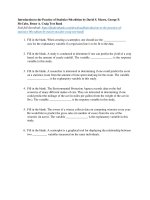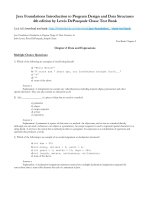Introduction to android application development android essentials 5th edition by annuzzi darcey conder test bank
Bạn đang xem bản rút gọn của tài liệu. Xem và tải ngay bản đầy đủ của tài liệu tại đây (168.12 KB, 3 trang )
Introduction to Android Application Development Android
Essentials 5th edition by Joseph Annuzzi. Jr, Lauren Darcey,
Shane Conder Test Bank
Link full download test bank: />
Chapter 2: Setting Up for Development
Multiple Choice Questions
1. What must developers enable on Android devices in order to install their applications?
a. ADTs
b. Emulators
c. Developer options
d. Certificates
2. Which one of the following provides a complete list of specific changes to the Android SDK?
a. API Diff Report
b. Release Notes
c. Overview of Changes
d. Errata Notification
3. Who retains all rights to Android apps developed with the SDK?
a. Google
b. Microsoft
c. Android, Inc.
d. The developer
4. Which one of the following packages provides encryption support?
a. org.json
b. javax.*
c. android.*
d. junit.*
5. What is the official Android development environment?
a. Android IDE
b. Xcode
c. Visual Basic
d. Android Studio
6. Megan wants to download and update the development tools while still maintaining
backward compatibility. What tool within the IDE will she use?
a. Android Compatibility Manager
b. Android SDK Manager
c. Android Time Manager
d. Android Virtual Device Manager
7. Within the IDE, what does a developer use to load Android applications, and test and
debug them?
a. AVD configuration
b. The Android emulator
c. A simulator
d. Test devices
Chapter 2: Setting Up for Development
Multiple Choice Questions 7
8. Which setting must you enable on an Android device to install Android applications
other than those from the Google Play store?
a. Unknown APKs
b. Unknown sources
c. Unknown applications
d. Alternative app stores
9. Android Studio is based on what other IDE?
a. Eclipse
b. Sublime
c. IntelliJ IDEA
d. XDA Developer
10. Who owns the copyrights and intellectual property rights to the material in the SDK?
a. The developer.
b. Google and third parties.
c. Android development leads.
d. The SDK is open source and not under copyright.
Chapter 2: Setting Up for Development
Multiple Choice Questions 8
Answers and Explanations
1. c. If developers do not enable Developer options, they will not be able to install
their applications on Android devices.
2. a. An API Diff Report provides a complete list of specific changes to the SDK. The Overview
of Changes is a brief description of the major changes to the SDK. The Release Notes are
a list of known issues with the SDK.
3. d. The developer retains all rights to any Android software developed with the SDK,
including intellectual property rights. Developers also retain all responsibility for their own
work.
4. b. The javax.* package provides encryption support. org.json provides JavaScript
Object Notation support. The Android fundamentals are included in the android.*
package. junit.* supplies functionality for unit-testing.
5. d. Android Studio
6. b. The Android SDK Manager facilitates Android development across multiple platform
versions simultaneously. When a new Android SDK is released, you can use this tool to
download and update your tools while still maintaining backward compatibility with
older versions of the Android SDK.
7. b. The Android emulator is one of the most important tools provided with the Android SDK.
You will use this tool frequently when designing and developing Android applications. The
emulator runs on your computer and behaves much as a mobile device would. You can
load Android applications into the emulator, and then test and debug them.
8. b. Unknown sources
9. c. IntelliJ IDEA
10. b. Google (as the copyright holder of Android) grants you a limited, worldwide, royalty-free,
nonassignable, and nonexclusive license to use the SDK solely to develop applications for
the Android platform. Google (and third-party contributors) are granting you license, but they
still hold all copyrights and intellectual property rights to the material. Using the Android
SDK does not grant you permission to use any Google brands, logos, or trade names. You
may not remove any of the copyright notices therein. Third-party applications that your
applications interact with (other Android apps) are subject to separate terms and fall outside
this agreement.
Chapter 2: Setting Up for Development
Answers and Explanations 9









